2012 Peugeot 3008 Hybrid 4 change wheel
[x] Cancel search: change wheelPage 34 of 284

HY
B
32
ZEV mode * (all electric)
Zero emissions vehicle operation is as-
sured 100 % by electric drive.
This mode forces silent running
at
moderate speeds.
* ZEV: Zero Emissions Vehicle. In ZEV mode:
- The accelerator control is progressive.
- Range and acceleration capacity are
limited. The maximum speed pos-
sible is around 36 mph (60 km/h).
- Under high load or a priority require-
ment causing the start of the Diesel
engine, the system changes auto-
matically to AUTO mode.
It can be activated when
the required conditions are
met, particularly if the state
of charge of high voltage
battery is suffi cient (4 bars minimum).
If the conditions do not allow
this mode, a message that
the "electric mode is not cur-
rently available" appears in
the screen. The ZEV warning
lamp fl ashes for a few seconds then
goes off and the selector comes on in
AUTO.
Auto mode
It automatically manages the operation
of the Diesel engine and the electric
motor, according to inherent vehicle pa-
rameters, traffi c conditions and driving
style so as to optimise the vehicle's
fuel consumption
.
In particular, this mode activates "zero
emissions" electric running
when the
conditions allow.
In auto mode, the electric motor
:
- can drive the vehicle on its own up
to around 36 mph (60 km/h) in "zero
emissions" electric running, depend-
ing on the state of charge of the bat-
tery, if the conditions specifi c to the
vehicle are met and if acceleration is
moderate,
- supplements the Diesel engine
when moving off and changing gear,
during acceleration and when trac-
tion from the front wheels is inade-
quate (it automatically adds
4 wheel
drive
),
- is no longer active above 70 mph
(120 km/h).
This standard
mode to use in
preference
is activated auto-
matically
on starting the hy-
brid system.
For more information on "Au-
tomatic restarting of the Diesel
engine or ZEV mode not avail-
able", refer to the corresponding
section.
Page 42 of 284
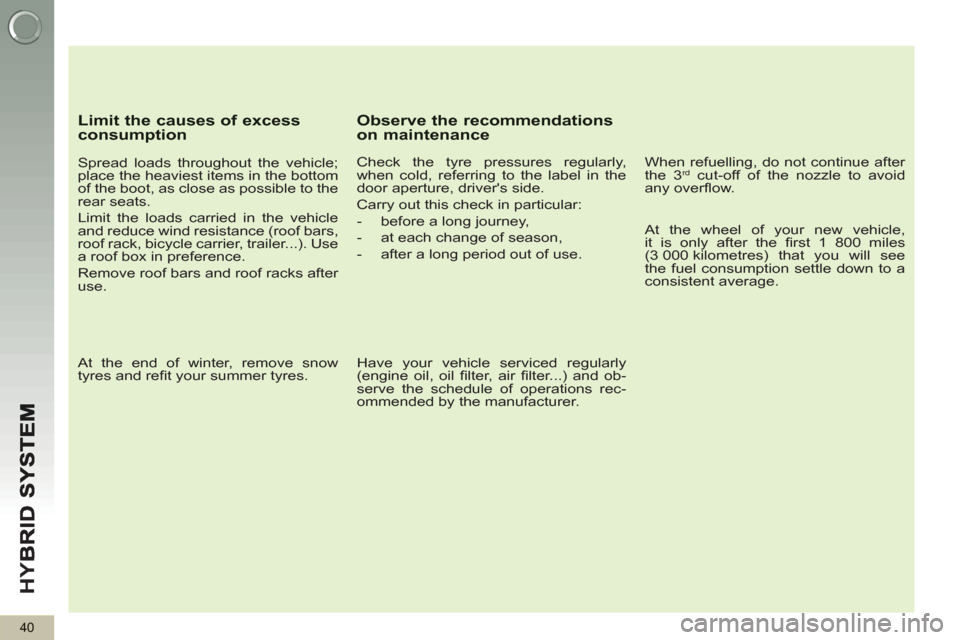
HY
B
40
Limit the causes of excess consumption
Spread loads throughout the vehicle;
place the heaviest items in the bottom
of the boot, as close as possible to the
rear seats.
Limit the loads carried in the vehicle
and reduce wind resistance (roof bars,
roof rack, bicycle carrier, trailer...). Use
a roof box in preference.
Remove roof bars and roof racks after
use.
At the end of winter, remove snow
tyres and refi t your summer tyres.
Observe the recommendationson maintenance
Check the tyre pressures regularly,
when cold, referring to the label in the
door aperture, driver's side.
Carry out this check in particular:
- before a long journey,
- at each change of season,
- after a long period out of use.
Have your vehicle serviced regularly
(engine oil, oil fi lter, air fi lter...) and ob-
serve the schedule of operations rec-
ommended by the manufacturer.
When refuelling, do not continue after
the 3 rd cut-off of the nozzle to avoid
any overfl ow.
At the wheel of your new vehicle,
it is only after the fi rst 1 800 miles
(3 000 kilometres) that you will see
the fuel consumption settle down to a
consistent average.
Page 158 of 284
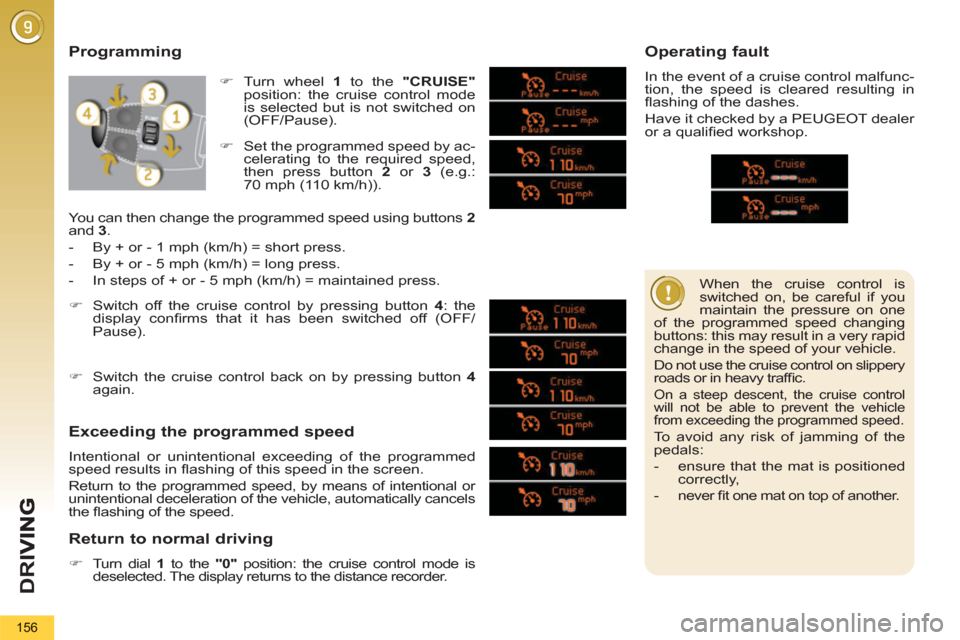
D
R
I
156
When the cruise control is
switched on, be careful if you
maintain the pressure on one
of the programmed speed changing
buttons: this may result in a very rapid
change in the speed of your vehicle.
Do not use the cruise control on slippery
roads or in heavy traffi c.
On a steep descent, the cruise control
will not be able to prevent the vehicle
from exceeding the programmed speed.
To avoid any risk of jamming of the
pedals:
- ensure that the mat is positioned
correctly,
- never fi t one mat on top of another.
Programming
Exceeding the programmed speed
Intentional or unintentional exceeding of the programmed
speed results in fl ashing of this speed in the screen.
Return to the programmed speed, by means of intentional or
unintentional deceleration of the vehicle, automatically cancels
the fl ashing of the speed.
Return to normal driving
�)
Turn dial 1
to the "0"
position: the cruise control mode is
deselected. The display returns to the distance recorder.
Operating fault
In the event of a cruise control malfunc-
tion, the speed is cleared resulting in
fl ashing of the dashes.
Have it checked by a PEUGEOT dealer
or a qualifi ed workshop.
�)
Set the programmed speed by ac-
celerating to the required speed,
then press button 2
or 3
(e.g.:
70 mph (110 km/h)).
�)
Switch off the cruise control by pressing button 4
: the
display confi rms that it has been switched off (OFF/
Pause).
�)
Switch the cruise control back on by pressing button 4
again.
You can then change the programmed speed using buttons 2
and 3
.
- By + or - 1 mph (km/h) = short press.
- By + or - 5 mph (km/h) = long press.
- In steps of + or - 5 mph (km/h) = maintained press.
�)
Turn wheel 1
to the "CRUISE"
position: the cruise control mode
is selected but is not switched on
(OFF/Pause).
Page 159 of 284
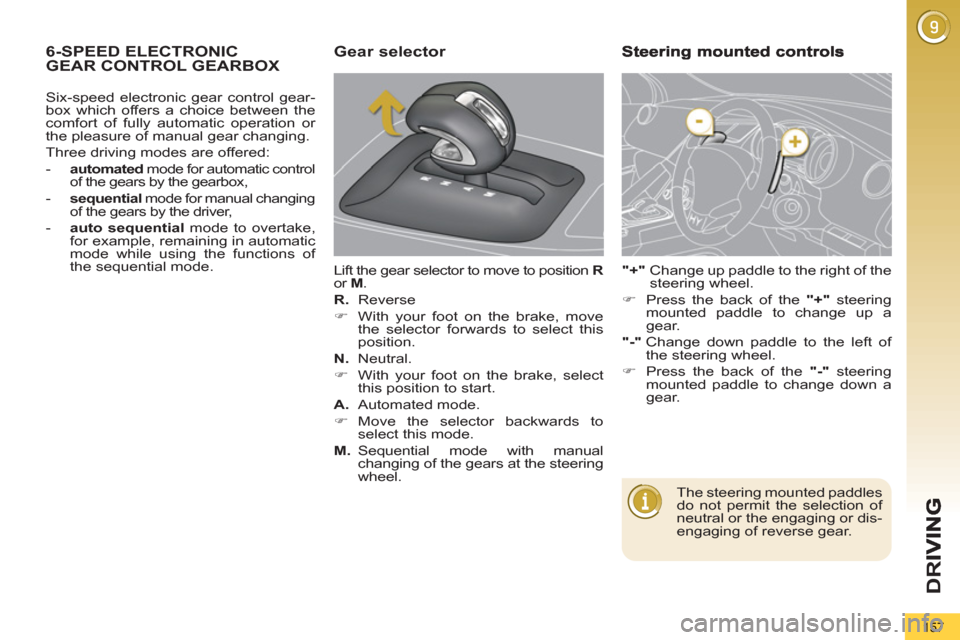
D
R
157
6-SPEED ELECTRONIC
GEAR CONTROL GEARBOX
Gear selector
Lift the gear selector to move to position R
or M
.
R.
Reverse
�)
With your foot on the brake, move
the selector forwards to select this
position.
N.
Neutral.
�)
With your foot on the brake, select
this position to start.
A.
Automated mode.
�)
Move the selector backwards to
select this mode.
M.
Sequential mode with manual
changing of the gears at the steering
wheel.
"+"
Change up paddle to the right of the
steering wheel.
�)
Press the back of the "+"
steering
mounted paddle to change up a
gear.
"-"
Change down paddle to the left of
the steering wheel.
�)
Press the back of the "-"
steering
mounted paddle to change down a
gear.
The steering mounted paddles
do not permit the selection of
neutral or the engaging or dis-
engaging of reverse gear.
Six-speed electronic gear control gear-
box which offers a choice between the
comfort of fully automatic operation or
the pleasure of manual gear changing.
Three driving modes are offered:
- automated
mode for automatic control
of the gears by the gearbox,
- sequential
mode for manual changing
of the gears by the driver,
- auto sequential
mode to overtake,
for example, remaining in automatic
mode while using the functions of
the sequential mode.
Page 179 of 284
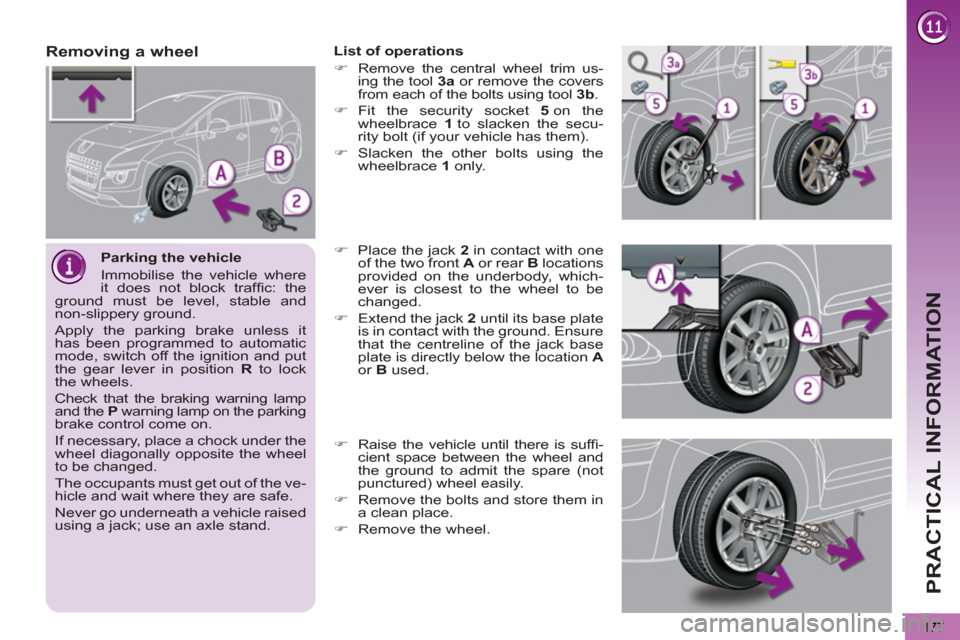
PRACTICAL INFORMATION
177
Parking the vehicle
Immobilise the vehicle where
it does not block traffi c: the
ground must be level, stable and
non-slippery ground.
Apply the parking brake unless it
has been programmed to automatic
mode, switch off the ignition and put
the gear lever in position R
to lock
the wheels.
Check that the braking warning lamp
and the P
warning lamp on the parking
brake control come on.
If necessary, place a chock under the
wheel diagonally opposite the wheel
to be changed.
The occupants must get out of the ve-
hicle and wait where they are safe.
Never go underneath a vehicle raised
using a jack; use an axle stand.
Removing a wheel
List of operations
�)
Remove the central wheel trim us-
ing the tool 3a
or remove the covers
from each of the bolts using tool 3b
.
�)
Fit the security socket 5
on the
wheelbrace 1
to slacken the secu-
rity bolt (if your vehicle has them).
�)
Slacken the other bolts using the
wheelbrace 1
only.
�)
Place the jack 2
in contact with one
of the two front A
or rear B
locations
provided on the underbody, which-
ever is closest to the wheel to be
changed.
�)
Extend the jack 2
until its base plate
is in contact with the ground. Ensure
that the centreline of the jack base
plate is directly below the location A
or B
used.
�)
Raise the vehicle until there is suffi -
cient space between the wheel and
the ground to admit the spare (not
punctured) wheel easily.
�)
Remove the bolts and store them in
a clean place.
�)
Remove the wheel.
Page 201 of 284
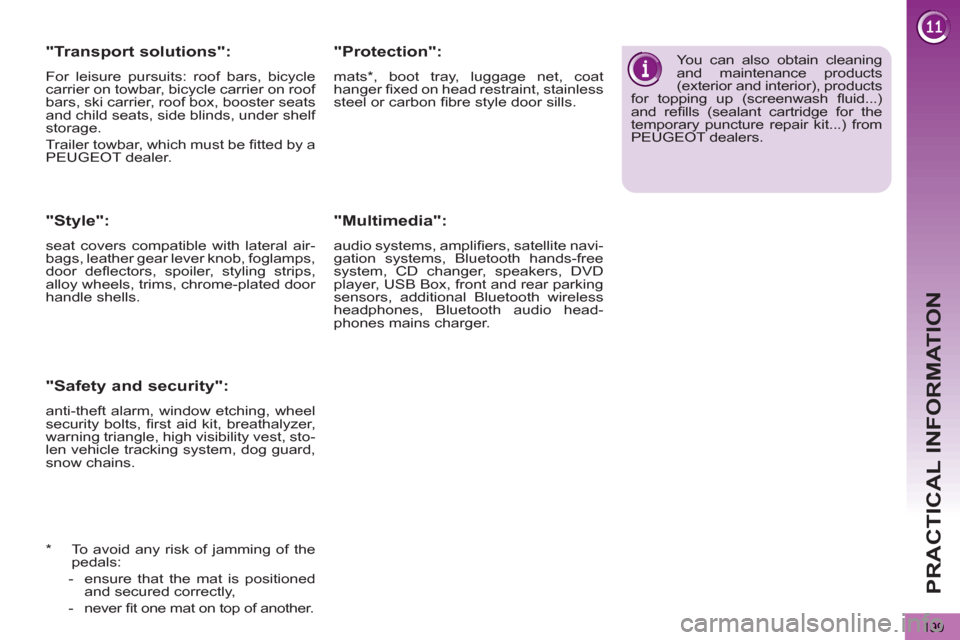
PRACTICAL INFORMATION
199
"Transport solutions":
For leisure pursuits: roof bars, bicycle
carrier on towbar, bicycle carrier on roof
bars, ski carrier, roof box, booster seats
and child seats, side blinds, under shelf
storage.
Trailer towbar, which must be fi tted by a
PEUGEOT dealer.
"Safety and security":
anti-theft alarm, window etching, wheel
security bolts, fi rst aid kit, breathalyzer,
warning triangle, high visibility vest, sto-
len vehicle tracking system, dog guard,
snow chains.
You can also obtain cleaning
and maintenance products
(exterior and interior), products
for topping up (screenwash fl uid...)
and refi lls (sealant cartridge for the
temporary puncture repair kit...) from
PEUGEOT dealers.
*
To avoid any risk of jamming of the
pedals:
- ensure that the mat is positioned
and secured correctly,
- never fi t one mat on top of another.
"Style":
seat covers compatible with lateral air-
bags, leather gear lever knob, foglamps,
door defl ectors, spoiler, styling strips,
alloy wheels, trims, chrome-plated door
handle shells.
"Protection":
mats * , boot tray, luggage net, coat
hanger fi xed on head restraint, stainless
steel or carbon fi bre style door sills.
"Multimedia":
audio systems, amplifi ers, satellite navi-
gation systems, Bluetooth hands-free
system, CD changer, speakers, DVD
player, USB Box, front and rear parking
sensors, additional Bluetooth wireless
headphones, Bluetooth audio head-
phones mains charger.